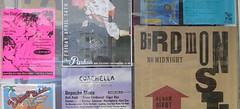Modern Architecture Goes for Suburbian Total

The Architecture Scholars love to hate suburbia. Tracts of little tract houses, block after block, their side-by-side roofs making "meaningless arrows" pointing to nowhere; their homes producing safe, walled cities where white-bread children are produced with factory-like perfection and similarity of mind.
This is the stereotype you'll learn from many an urban studies class in the American university. Architecture professors rattle on with grim resignation about a nation which, they believe, has no taste, and has sacrificed community intermixing (in the traditional plan of mixed-use downtowns) to selfish isolation. Traditional pointy-roofs are the token of a homogeneity and tastelessness that they find revolting.
So it takes an outsider from the provinces to break with those expectations. Which is exactly what's happening in a south-of-the-river, ghetto-fringing upscale development of Dallas, Texas, Kessler Woods.

Ironically, however, the new modern veneer comes in the same large-scale, large-tract developments as before. Sophisticated Dallas architects of intersecting slabs and floating glass staircases and native limestone encroachments -- like Hammers + Partners -- are essentially producing glorious icons set into the same isolated developments of isomorphic suburban retreat as populate other walled communities:
He currently has a midcentury modern home in North Dallas and said there's an appeal to living in a neighborhood with the same architecture.
'Aficionados a lot of times see a contemporary house they like, but because of the surroundings, there is a battle of styles going on,' Mr. Moore said. 'To be able to live in that aesthetic and walk the street and be surrounded by it is amazing to me.'
-- Steve Brown, Dallas Morning News, "It's a Mod, Mod World"
What's so fascinating about this is the claim that modernist architecture sets up for itself. Berkeley Architecture stars like Stanley Saitowitz love to tout postmodernism's ability to fit into its urban setting; indeed San Francisco urban planning boards mandate certain details of architectural design to force new buildings to adopt, wherever possible, bow windows and cornices in order to fit into the urban pattern set by the city's major period of late nineteenth-century expansion. Postmodern architecture fits into the city framework and promotes a certain social view for the long-term: creating reusable frames in which residential and commercial uses can intermingle and shift, depending on the needs of future users.
Now "mid-century modern", as its called, is bucking the promise of postmodernism in the greatest way. Rich native Texas limestone, to be sure, is used wherever possible, to be sure. And to be sure, these suburbs merely keep the pattern of most of those new developments around Dallas.
 The first risk, of course, is the increasing social divisions implied by architecture that keeps to these strict patterns in an already socially divided city like Dallas, where the color line starts at the Trinity River. The community not far from these fantastic flights of glass and limestone has as much texture as a detective novelist or urban historian could wish for.
The first risk, of course, is the increasing social divisions implied by architecture that keeps to these strict patterns in an already socially divided city like Dallas, where the color line starts at the Trinity River. The community not far from these fantastic flights of glass and limestone has as much texture as a detective novelist or urban historian could wish for. Walled communities insure that those of different incomes are kept far away. Social worlds will never meet on the terms of this kind of planning. This is architecture that can only tear down and gentrify large tracts of land.
The second risk is related. As land gentrifies, the Latino communities south of the river will be pushed further away. Bad for brown folks who need to commute; but quite possibly, bad for white folks too. For these homes are expensive to get to and expensive to maintain. As we face the coming age of Peak Oil, since now half of the world's natural resources are already gone while worldwide consumption steadily mounts, these homes won't be feasible for use much longer.
A pity, because the new McMansions really are quite pretty, after all.
Related fantasy worlds:
- Celebrity modern architecture developments in furthest West Texas, from the Texas Observer
- Further on the gentrification of Dallas: Jim Schutze, "You Can Go Home Again," Dallas Observer, Published: Thursday, May 18, 2000:
It's not that Oak Lawn was a bastion of rare and valuable architecture, anyway, but there were old-fashioned "community service" business strips with shoe-repair places and dime stores--things that spoke of a past of some kind. Their total erasure isn't a moral wrong, according to Miller: It's just that the template is lost, so everything there now feels instantaneous and thin the way it does in the suburbs.
- The extremely fascinating multiblog site, Metroblogging Dallas, which asks and answers questions like this one:
Are some cities more romantic than others? Does the lifestyle certain cities lend themselves to make love more or less likely to strike and to survive when it does? How does Dallas rate as a love-conducive metro area?
Technorati Tags: cities, cities, urbanplanning, stratego, gentrification, class, architecture, neighborhoods, dallas










0 Comments:
Post a Comment
<< Home